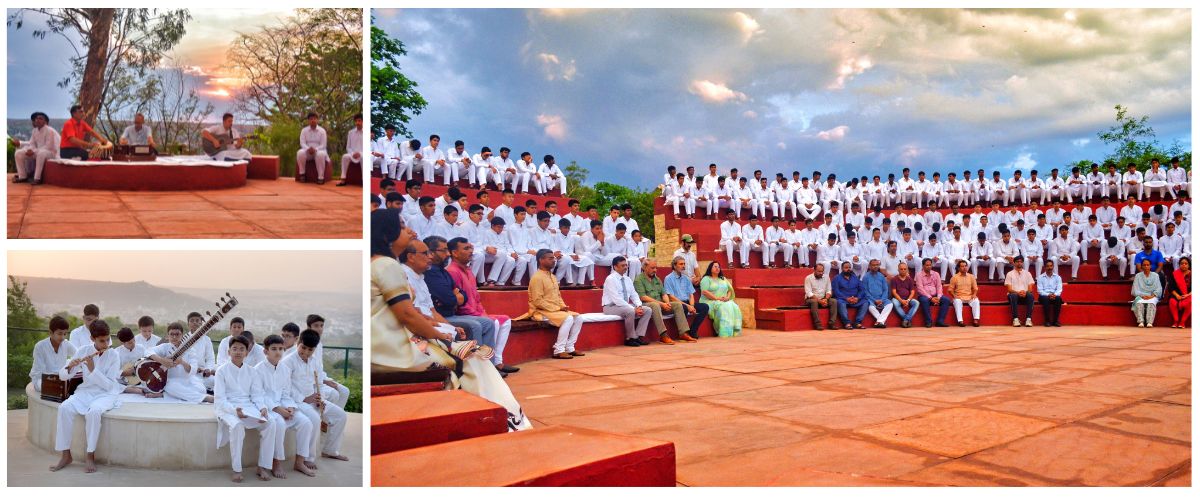Astachal: The spiritual heartbeat of The Scindia School
– Ajay Singh, Principal, Scindia School
Astachal means the hill at sunset, but for The Scindia School it stands for a soul-stirring practice. Every evening an endearing sight unfolds in the school. Come the twilight hour, dressed in crisp white kurta pyjamas, the boys assemble in the Amphitheatre called Astachal, the spiritual watering hole of our school.
When the young Scindians sit in contemplation for Astachal, their faces mirror the orange hue of the setting sun, a comforting silence only broken by the azaan, or the temple bells heard above the din of the bustling city, or the chirping of the flock of birds returning to their nests after a hard day’s work.
What feeling does it enthuse in these impressionable kids? The lone towering statue of Mahatma — a silent witness to the Scindian travails or a testimony to the timelessness of the message of Ekla Chalo? Does it inspire awe? Or is it just sitting with oneself, assured of the fact that a new day will dawn tomorrow? What transpires between the kids and nature is unfathomable and open to infinite interpretations. Only one fact is irrefutable. Even after they have passed out from the school, they return to Astachal year after year to rejuvenate, reminisce and consolidate their bond with the Alma Mater. And the Astachal welcomes its own — the young and old alike.
As Mitul Dixit (ex-Madhav, 1993) says:
“Astachal is where the heart of every Scindian finds rest. As the sun dips beyond the majestic fort wall, its golden light bathes Gandhiji’s statue in quiet reverence. Clad in white kurta pyjamas, the boys sit in meditative stillness — fifteen minutes that suspend time, shaping minds and hearts, instilling peace, reflection, and a sense of eternal belonging. The imprint lasts a lifetime, lingering long after the school gates are left behind.”
Perhaps that is why Astachal continues to hold its magic.
Sandeep Agrawal (ex-Shivaji, 1980) reminisces:
“Memories of the Astachal reside within the souls of generations of Scindians spread across the world. It is a place where silence speaks louder than words; where the setting sun ventures to energise each one of us with the last vestige of its fading ray of that day.”
The Astachal has interesting origins. It was conceived in the 1930s as a common spiritual space by the then Principal Mr. F.G. Pearce and his senior colleague and future Principal, Mr. K.C. Shukla. Mr. F.G. Pearce was deeply influenced by Indian philosophy. He was responsible for giving the school a uniquely Indian ethos and for laying the foundations of a culture that is better known as ‘Scindian’ to this day.
Thakar, a teacher, produced the clay model based upon which the construction was completed in 1943. The space was christened ‘Astachal’. The statue of the Mahatma, symbolising the eternal seeker, was sculpted by Rudrappa of Gwalior, and added in 1948. Long before mindfulness apps, wellness retreats, and digital detoxes became popular, The Scindia School had embedded this timeless practice into daily life. In Astachal, students learn that true leadership and wisdom begin with self-awareness.
Rahul Kulshreshtha (ex-Ranoji, 1981) fondly remembers:
“Studying at The Scindia School (1975–81) was a magical journey within the timeless walls of Gwalior Fort. The most cherished memory remains our evening ritual, Astachal. At sunset, dressed in white kurta–pyjamas, we gathered by Gandhiji’s statue. Teachers played music, sang, or told stories, followed by a minute of silence. That quiet reflection, against the glowing sky and setting sun, shaped values and memories that every Scindian carries for life.”
Nurturing the soul has always been an integral part of the school’s philosophy. The practice of Astachal, after a long and demanding day filled with academics, sports, and co-curricular activities, offers students a moment of respite — a pause for peace and reflection. In the stillness of the evening, they engage in quiet introspection, contemplating both their successes and setbacks. Here, they learn the value of being one with nature, and the profound spiritual experience of this serene space stays with them as a lifelong treasure.
In today’s fast-paced, hyper-connected world, where young people are constantly pulled by screens, information overload, and the pressure to perform, Astachal offers something rare and precious: stillness. The fifteen minutes of silence are more than a ritual; it is an opportunity to pause, to process the day’s triumphs and failures, and to discover that strength lies not in noise but in silence and reflection.
Also Read: The Scindia School, Gwalior
















Add comment